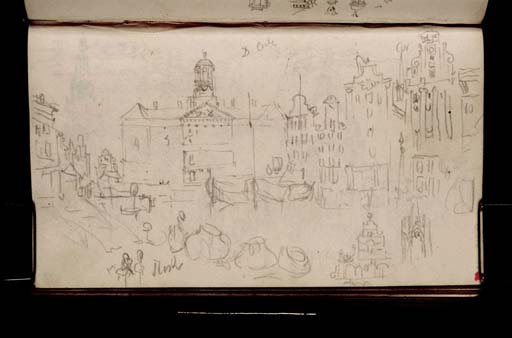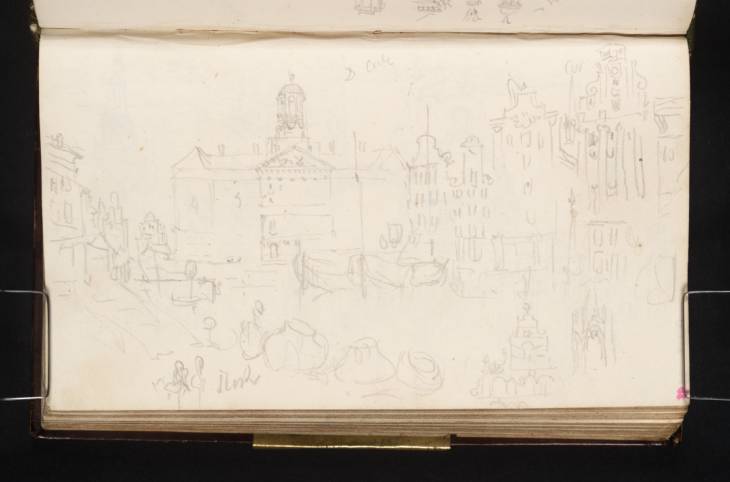Joseph Mallord William Turner The Royal Palace, Amsterdam, across the Dam Square to the West, with Boats on the Damrak; Studies of Storks, Baskets or Sacks and Architectural Details 1825
Image 1 of 2
-
 Joseph Mallord William Turner, The Royal Palace, Amsterdam, across the Dam Square to the West, with Boats on the Damrak; Studies of Storks, Baskets or Sacks and Architectural Details 1825
Joseph Mallord William Turner, The Royal Palace, Amsterdam, across the Dam Square to the West, with Boats on the Damrak; Studies of Storks, Baskets or Sacks and Architectural Details 1825 -
 Joseph Mallord William Turner, The Royal Palace, Amsterdam, across the Dam Square to the West, with Boats on the Damrak; Studies of Storks, Baskets or Sacks and Architectural Details 1825 (Enhanced image)Enhanced image
Joseph Mallord William Turner, The Royal Palace, Amsterdam, across the Dam Square to the West, with Boats on the Damrak; Studies of Storks, Baskets or Sacks and Architectural Details 1825 (Enhanced image)Enhanced image
Joseph Mallord William Turner,
The Royal Palace, Amsterdam, across the Dam Square to the West, with Boats on the Damrak; Studies of Storks, Baskets or Sacks and Architectural Details
1825
Joseph Mallord William Turner 1775–1851
Folio 98 Verso:
The Royal Palace, Amsterdam, across the Dam Square to the West, with Boats on the Damrak; Studies of Storks, Baskets or Sacks and Architectural Details 1825
D19034
Turner Bequest CCXIV 98a
Turner Bequest CCXIV 98a
Pencil on white wove paper, 95 x 155 mm
Inscribed by Turner in pencil ‘D C[?ul]’ top centre, ‘C[?or]’ top right, ‘4’ and ‘5’ left of centre, on façade, and ‘Storks’ towards bottom left, beside birds
Inscribed by Turner in pencil ‘D C[?ul]’ top centre, ‘C[?or]’ top right, ‘4’ and ‘5’ left of centre, on façade, and ‘Storks’ towards bottom left, beside birds
Accepted by the nation as part of the Turner Bequest 1856
References
1909
A.J. Finberg, A Complete Inventory of the Drawings of the Turner Bequest, London 1909, vol.II, p.654, CCXIV 98a, as ‘Do.’ (i.e. ditto: ‘Buildings’).
1994
Fred G.H. Bachrach, Turner’s Holland, exhibition catalogue, Tate Gallery, London 1994, reproduced p.66, as ‘Royal Palace. Inscribed “Storks” [kept to clean fishmarket]’.
Finberg later annotated his basic 1909 Inventory entry (‘Buildings’): ‘Amsterdam Town Hall’.1 The Turner scholar C.F. Bell marked another copy in the same way.2 With the page turned horizontally, the view is west across the Dam square, with the Baroque cupola and pediment of the Royal Palace (Koninklijk Paleis) picked out in detail on the far side. It was indeed built as the town hall, but it was first designated a palace in 1808 and remains at the disposal of the current Dutch royal family.3
As was customary with regular façades, Turner only drew as much detail as required to infer the rest, marking the blank sections to the left of the pediment ‘4’ and ‘5’ to indicate their articulation. The numbers are inconsistent in this case, as the projecting corner sections feature three bays of windows between four pilasters, while the inner sections have five windows separated by four pilasters. The details of the central section are barely sufficient to indicate its seven bays of windows, let alone the writhing sculptural mass of gods and mythical beasts carved in high relief within the pediment; other aspects of the palace are studied on folios 99 recto opposite and its verso (D19035–D19036).
The houses on the right do not survive, leaving a clear view of the Gothic Nieuwe Kerk to its north; only the church’s slender crossing spire is shown here, between the elaborate gables, and apparently again below, along with other architectural details. The moored boats are at the inner, southern end of the Damrak canal, of which this section has since been filled in. There is a slighter variant of the present view on folio 82 recto (D19001), and the palace and church are occasionally seen in the distance on other pages, notably on folio 106 recto (D19049).
At the bottom left are several irregular objects which are likely baskets or sacks associated with the scene. There are also two storks, which are labelled as such; the Dutch Turner scholar Fred Bachrach has noted that the birds were ‘kept to clean [the] fishmarket’.4 See under folio 81 recto (D18999) for other views in and around the city in this book and elsewhere, and its Introduction for discussion of its many studies of shipping, everyday items noted at markets and in other contexts, and occasional animals and birds.
Matthew Imms and Quirine van der Meer Mohr
September 2020
Undated MS note by Finberg (died 1939) in interleaved copy of Finberg 1909, Prints and Drawings Room, Tate Britain, II, p.654.
Undated MS note by Bell (died 1966) in copy of Finberg 1909, Prints and Drawings Room, Tate Britain, II, p.654.
See ‘About the Palace’, Royal Palace Amsterdam, accessed 20 March 2020, https://www.paleisamsterdam.nl/en/about-palace/ .
How to cite
Matthew Imms and Quirine van der Meer Mohr, ‘The Royal Palace, Amsterdam, across the Dam Square to the West, with Boats on the Damrak; Studies of Storks, Baskets or Sacks and Architectural Details 1825 by Joseph Mallord William Turner’, catalogue entry, September 2020, in David Blayney Brown (ed.), J.M.W. Turner: Sketchbooks, Drawings and Watercolours, Tate Research Publication, March 2023, https://www

